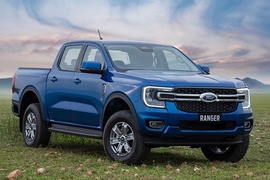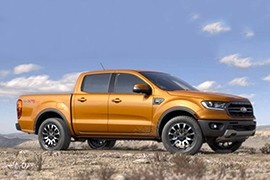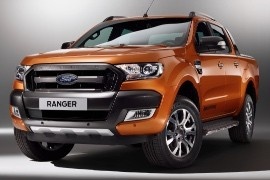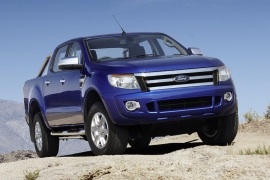
FORD Ranger Double Cab
Generations Timeline, Specs and Pictures

Ford introduced the fourth-generation of the Ranger lineup (fifth including the North-American model) in late 2021, even though its sales across Europe and other countries placed it on the top of its segment.
Ford designed the 2021 Ranger with a strong inspiration from its American sibling F-150 and the Bronco. Its C-shaped daytime running lights surrounded the outer sides of the headlights, which flanked the wide, massive grille. The car featured a small front-view camera under the blue-oval logo mounted a few inches below the hood’s edge depending on the trim level. Under the bumper, Ford installed two recovery hooks welded directly onto the chassis. The front fenders sported a vent behind the wheel-wells, allowing the warm air to escape the engine compartment. It was a unique feature in its class.
The carmaker placed a step integrated into the rear bumper at the back, which eased up the bed’s access. Unlike in the previous versions, Ford stamped the Ranger nameplate onto the tailgate and integrated the third brake light. Thanks to the repositioning of the rear dampers, the bed was wider between the wheel-arches. It was wide enough to fit a Euro-pallet between them.
Inside, the carmaker placed a new SYNC4 infotainment system with an 8” touch screen (landscape mode) or a 12” unit (portrait-mode) as an option. In addition, inside the instrument cluster, the carmaker placed a TFT display that replaced the older analog dials.
Under the hood, Ford announced a two-liter turbodiesel available in two power outputs, or a V6 oil-burner developed with Volkswagen. In addition, a six-speed manual or a ten-speed automatic was available, depending on the version and options. A 2.3-liter EcoBoost gasoline powerplant and a hybrid option were available in specific markets.

After eight years, Ford Ranger returned to the U.S. market, trying to get back its place in the mid-size pickup segment.
Instead of researching a completely new product, the blue-oval brand just adapted the European/Australian Ranger. While that version was good on markets where the regular F-150s looked like monster trucks, in the U.S. was less impressive. Its old chassis and inline-four engines had to deal with Chevy Colorado or Toyota Tacoma, who was doing good on the U.S. market. But Ford knew it couldn’t lose.
With its SUV-like front fascia, enhanced by a skid plate under the bumper and LED daytime running lights on top of the headlights, the 2018 Ranger Double cab tried to be the family friend that could jump and help with anything. Its four-door cabin and separated bed proved to be the best choice for a mixed-use vehicle. It could successfully handle the family needs such as school runs and shopping, and on the weekend, it could haul a few thousand pounds up to a mountain lodge.
Inside, the carmaker installed a car-like dashboard with a SYNC infotainment system on top of the center stack. The instrument panel placed in front of the driver showed a center-mounted speedometer flanked by two TFT displays. Ford managed to take the driveshaft lower under the cabin, so there was no hassle on the rear seats. Three people could sit well on the bench, while the front seats offered plenty of room.
The carmaker installed a 2.3-liter EcoBoost (turbocharged) gasoline engine paired as standard with a ten-speed automatic gearbox. Two other turbo-diesel versions were available as well, especially for the Canadian market.

Ford introduced the T6 Ranger in 2011 and enhanced it several times, and made it compliant with the Euro 6d regulations after the 2015 facelift.
Thanks to its vast experience in building pickups, it was no wonder that it became an absolute market leader in Europe. Even the best cars needed some upgrades from time to time, and Ford improved the T6 Ranger in 2015.
Ford’s design department worked hard to change the car’s look. It lost the chrome-plated three-slats grille design, but it gained a massive black one instead. The three slats were still there but smaller and almost concealed by the rest of the front fascia. Underneath, an aluminum skid plate protected the engine and the transmission from bumps and rocks. Its headlights were narrower. As for the fog lights, those were still rounded but protected by angular-shaped glasses. It wasn’t that much changed from its sides, although Ford offered it with new options for light-alloy wheels.
Inside, it was a completely new interior, with better materials and an SUV-like design. The SYNC 2 infotainment system adorned the top of the center stack. Inside the instrument cluster, Ford included two TFT displays that flanked the center-mounted speedometer. Its four doors allowed the owner to use it as a family vehicle, but the rear seats were not the most comfortable on the market.
Under the hood, Ford offered the Ranger Double Cab with two engine choices: a 160 hp 2.2-liter and a 200 hp 3.2-liter inline-five. Both sent their power through a six-speed manual fitted as standard. The latter was available exclusively on the Wildtrak version.

The third generation of the international version of the Ford Ranger was launched in 2011 in Australia.
It was designed by Ford Australia and it also was sold in Europe.
There was a completely new chassis for the 2011 Ranger, or the T6 version as it was internally named. Destined for sale across five continents and more than 180 markets, Ford Ranger was offered as a complete family of compact trucks - with three different cab body styles, 4x2 and 4x4 drivetrains, two ride heights and up to five trim levels, depending on the market.
The new styling saw an approach toward the leisure sport-utility truck vehicles. It was the same rugged off-road vehicle, but the bodywork lines were closer to the look of an SUV. Its design also took into consideration the aerodynamic factor so the lines were smoother. The big headlights were flushed to the front fascia. To amplify the width of the car, the grille had horizontal lines and the bumper was taller than before.
The top-model was the Double Cab version. It was built to offer room for five passengers. Under the rear bench there was a small storage room and in the center console there was enough room for a laptop. The interior features could have been compared to an SUV. Leather and heated seats, touch-screen infotainment system with Bluetooth connectivity were on the option list.
Three engines were available, including a 2.2-liter inline-four-cylinder and a 3.2-liter inline-five. For specific markets, there was also a new 2.5-liter Duratec four-cylinder gasoline engine that Ford says will have more power than its major competitors and is flex-fuel capable. For the transmission, the Ranger was offered in a 4x4 or 4x2 configuration, with a 5-speed manual or 6-speed automatic.























































